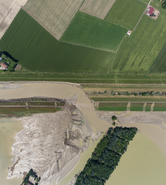In Europe, severe convective storm (SCS) losses have become an increasing concern for the insurance and reinsurance markets, with annual losses exceeding five billion euros for three consecutive years.
Whether from large hail, thunderstorms, flash flooding, powerful straight-line winds, and even tornadoes, SCS events have contributed to significant losses at the European level.
Italy was recently hit hard by extreme SCS events in summer 2023 causing roughly €6 billion of insured loss over the whole year.
The impact was so severe that it dwarfed the significant insured flood losses in the Emilia-Romagna region, caused by two severe rainfall events in May 2023[1], where floodwaters inundated dozens of towns and villages across over 100 municipalities in the four eastern provinces of Ravenna, Forlì-Cesena, Bologna, and Rimini.
Fifteen people were killed, and around 36,000 people were evacuated, amounting to roughly €500 million according to PERILS.[2]
Later in 2023, between July 18 and 25, severe convective storms affected the same region several times, with clustered hail events in northern Italy’s Po Valley. The largest hailstone observed in Italy – measuring a staggering 6.3 inches (16 centimeters) – was reported in Veneto on July 19.
Five days later, supercell storms in the Friuli Venezia Giulia region produced a new record-breaking hailstone that measured 7.5 inches (19 centimeters). The insured losses from this week of SCS activity alone exceeded €5 billion.
Each SCS Event is Different
While at the European level, annual multi-billion losses are to be expected, at the country or regional levels, such magnitude losses are still a surprise, and often unprecedented in many places. In Italy in 2023 and France in 2022, SCS losses from these countries contributed the most to the annual overall European losses in their respective years.
For the Italy and France SCS events, annual losses were roughly 10 times higher than the average annual loss in the preceding decade. In both instances, observed hazard severities were extreme, together with significant loss creep, i.e., an increase in the loss estimates with time.
It would be a hasty conclusion to think the extreme SCS in France during 2022 repeated itself in Italy in 2023, as despite the similarities, the nature and characteristics of the significant annual losses in both countries are different.
In France, the annual losses came from a series of events affecting different areas in France throughout the SCS season in 2022. In Italy, however, most losses were caused by a series of SCS events affecting similar regions in the Po Valley in Northern Italy over roughly one week.
This illustrates the issues and challenges associated with SCS: Overall increasing losses, significant loss creep during recent events, volatility of losses year-to-year, and a lack of observational, (severe) claims, and exposure data, to name a few.
On top of that, climate change may be important when looking at today’s risk and in the future. All of that contributes to an increasing concern for the insurance and reinsurance market when managing the risk of SCS.
Hail Activity in Italy
The drivers behind the unprecedented losses in Italy in 2023 (and significantly increasing losses in the years before that) can be linked directly to a strong increase in hail activity in the recent decade or so.
Our research shows that this signal is strongest in Northern Italy, driven by a significant increase in Convective Available Potential Energy (CAPE) linked to higher sea surface temperatures in the Mediterranean Sea providing favorable conditions for more frequent SCS events.
These findings have been confirmed by an independent study that came out recently (Battaglioli et al., 2023). Trends of the same magnitude could not be found elsewhere in Europe. In short, the story is complex, but the recent events have highlighted the need for a paradigm shift in how SCS risk is managed.
Moving Beyond Secondary Peril Status
For too long SCS has been considered a ‘secondary peril’ managed by insurers through examining claims histories alone, as SCS events produce frequent claims leading to extensive claim records. Yet, as recent events have highlighted, these claim records often do not include higher-severity events.
And even if they do, such claim records tell us little about when and where extreme events will likely hit next time around. Will it be in an area with extensive solar farms and greenhouses, or a densely populated area with residential properties that have become more vulnerable to hail damage due to added exterior insulation – which is the case for many homes in Italy?
Models are a crucial tool to provide robust answers to these questions and help better explore the unaccountable. Going forward, as an industry, we need to elevate our approach to managing SCS risk in Europe, to become more resilient to recent events like the ones in France and Italy.
We need to make sure SCS does not constitute a significant Earnings Risk, eating into the bottom line year-on-year anymore, which it is today[3].
A move to modeling Europe SCS needs to become the new standard, plus better capture and sharing of exposure characteristics for SCS, will ultimately lead to risk transfer based on robust modeling results.
The role of Moody’s is to provide up-to-date, robust, comprehensive, and independent modeling solutions, to help the market understand and manage the complexities of SCS risk.
The recent release of Version 1.1 Moody’s RMS Europe Severe Convective Storm HD Models on the Intelligent Risk Platform™ is a testimony of our commitment to the market. We have updated the model to align it to the current climate, incorporating recent changes in exposure characteristics and vulnerability, and building in new learnings and data from recent events.
The up-to-date view of SCS risk across 17 European countries modeled with an overarching correlated stochastic event set, explicitly capturing hail, straight-line wind, and tornado risk, seamlessly integrates with our Europe Windstorm HD Models for a full expression of wind risk in Europe.
Moreover, together with our Europe Inland Flood HD Models, this delivers a comprehensive view of climate risk as part of our Europe Climate HD Models suite.
If you want to know more, please get in touch with your customer success representative, or click here for more information on severe convective storm models for Europe.
References
Battaglioli, F., P. Groenemeijer, T. Púčik, M. Taszarek, U. Ulbrich, U. and H. Rust. 2023. “Modeled Multidecadal Trends of Lightning and (Very) Large Hail in Europe and North America (1950–2021).” Journal of Applied Meteorology and Climatology: 62(11): 1627–1653.
[1] See the blog From Severe Drought to Severe Flood: Italy Hit Hard by Extremes for more details on this flood event
[2] https://www.perils.org/losses
[3] Earnings risks can be defined as catastrophes but also the smaller and more frequent events that eat into year-over-year earnings. The (re)insurance market is currently facing an important challenge due to the impact of natural catastrophe volatility on earnings risk, a metric that is fundamentally important for insurance firms to manage and attract investor attention and to remain resilient. For more details, refer to the white paper Mastering Earnings Risk: A Study on Europe Climate Portfolio Management.








